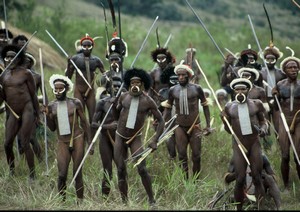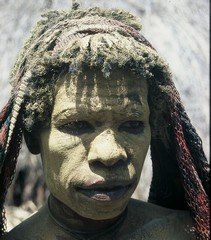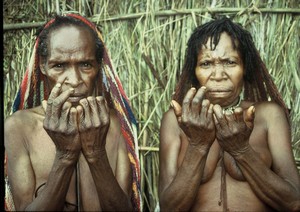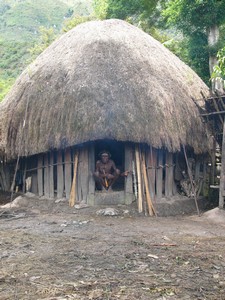The Preamble to the Constitution of 1945 establishes Pancasila as the embodiment of the fundamental principles of an independent Indonesia. These five principles are announced Sukarno speech, known as the "Birth of Pancasila," which he gave Independence Preparatory Commission for the June 1, 1945. In a short time, and the Constitution, the principles of Pancasila are: belief in a supreme god, humanism, nationalism is expressed in units of Indonesia, the board of democracy and social justice.
Opinion of Sukarno's Pancasila, while simple in form, due to the complex and sophisticated appreciation of the ideological needs of the new nation. In contrast to Muslim nationalists who insisted on an Islamic identity for the new state, the authors have called Pancasila culturally neutral identity, compatible with democracy or the Marxist ideology, and a full range of cultural differences in a heterogeneous population. As the national language - Bahasa Indonesia - which Sukarno also promoted, Pancasila does not reach a certain ethnic group, and was designed to define the fundamental values of culture, "Indonesian" political.
While Pancasila is the modern point of view, Sukarno introduced in terms of a traditional Indonesian society, which parallels the nation an ideal village, where the company is equal, the economy is organized on the basis of mutual self-help (gotong royong ), and the decision-making is by consensus (musyawarah-mufakat). In the version of Sukarno's Pancasila, a political and social dissidence constituted deviant behavior. Suharto changed this point of view, to the point that one of the criticisms of his version of Pancasila is that it has tried to Javanize arguing that a key element of Pancasila was ilmu kasunyatan (Supreme Wisdom), who practices kebatinan.
One of the reasons why so many Sukarno and Suharto have successfully used the Pancasila to support his authority, despite their very different political orientations, was the widespread nature of the principles of Pancasila. The Pancasila was less successful as a unifying concept when the administration tried to give a political content. For example, in 1959, Sukarno proclaimed a new unit called a major theme Nasakom - a trinity of state nationalism, communism and religion - as the revolutionary base for a "just and prosperous society." Oppose the PKI, under this model was to be anti-Pancasila.
However, the main opposition to this kind of ideological correctness was ABRI, Sukarno creating political problems in the military. Suharto, however, received support from the army, it does not require ideological conformity. ABRI, without actively promoting the Pancasila, rather than support for power sharing. Suharto said that cooperation at the time the national leadership of August 16, 1984, when he said that ABRI, with its dual role, was "a force that maintains and updates the Pancasila democracy."
Unlike Sukarno, the use of ideological appeals often seemed to be a substitute cynical and manipulative to get tangible results, even during an excuse for political fiasco, Suharto government sought to engage in policy and practice who have contributed to stability and development. In 1973, the reorganization of political parties - from the nine (plus Golkar) that contested the 1971 elections for two (plus Golkar) - has been justified as a step towards Pancasila democracy.
Beginning in 1978, became a national indoctrination program dedicated to instilling values of Pancasila all citizens, especially schoolchildren and officials. Of an abstract statement of national goals, Pancasila was now used as an instrument of social and political control. To oppose the government was to oppose Pancasila. To oppose Pancasila was to oppose the establishment of the State.
Efforts to enforce the government's interpretation of Pancasila ideological correctness was not without controversy. Two issues in particular renewable tested the limits of government tolerance of alternative or even competing systems of political thought. The first question was the establishment of religion, particularly Islam, the second issue was the role of legal opposition in democracy Pancasila.
From the principle of independence, Islam and the Indonesian state had a relationship of political tension. The promotion of Pancasila is a statement of monotheism religiously neutral and tolerant Islam equal to other religious systems: Christianity, Buddhism and Hindu beliefs, Balinese. However, the Muslim forces had felt betrayed policy since the signing of the Charter of 1949 in Jakarta, which agreed to a pluralistic republic in exchange for an agreement that the state is based on the belief in a God Muslims must comply with Islamic law. The government's failure to act in the Constitution and the law in this commitment to set the agenda for the future of Islamic politics. At the eastern end of the Darul Islam rebellion of the 1950s, which sought to establish a Muslim theocracy.
New Order Pancasila emphasis has been marked by an orthodox Muslim groups in an attempt to subjugate Islam in the secular state ideology, even the "civil religion" to manipulate the system naturally unilaterally full expression of Muslim life. In fact, in 1985 the government restricted its efforts to tame all the elements of social legislation Pancasila, which requires that all charitable organizations to accept Pancasila as the sole ideological principle, and provides for government supervision, intervention, and if necessary, to ensure compliance with the dismantling of their organizations.
Delivered "perfection" and the Pancasila democracy, the mass organizations went to the heart of the intention of the law of religious-based groups. This decision was forced into a Muslim-oriented PPP of its 1984 national congress, which had stage-managed by the government. For some Muslims, was the last straw. Guarantee of the Board of Directors that Muslims do not threaten the law appeared to be empty, since the new law limits the practice of Islam, the family, the mosque and prayer, rather than Islam, wrap the fullness of human even politics.
The environment was aggravated with the radical Muslims, incited by the priest burning, stand directly opposed, including political violence. Board of dissidents stern response - a quick stop, Subversion trial and long prison sentences - will soon be prevented any open confrontation with the public interest.
On the other side of the 1980s within the legal limits and politically acceptable to the participation of Muslims, the state has been a strong supporter of Islamic institutions. The government has even supported a number of Muslim activities. Within the overall structure of the value of Pancasila, Islamic moral and personal conduct of the materialism inherent in the balanced economic development for centuries. Suharto himself went to great lengths to show that he was a good Muslim, including making the pilgrimage to Mecca in May 1991.
In August 1991, he promised rp3 dollars to a new Islamic bank (Bank Muamalat Indonesia) and said he would encourage other wealthy Muslims to contribute. By courting Islamic leaders and teachers, won the state wide support for its development policy. There is no doubt that Islam was a state religion promoted in Indonesia, but it was not a state religion. What really sets the policy issues most critical to many orthodox Muslims. In addition, questions remained how the opposition - religious or secular - could be expressed in the work of Pancasila democracy.
Five heads of Pancasila
Believe in One God
Alone, and civilized humanity
Unity of Indonesia
Democracy guided by inner wisdom in the unanimity arising out of deliberations amongst representatives
Social justice for all the people of Indonesia
Belief in the one and only God
This principle of Pancasila reaffirms the Indonesian people's belief that God exists. It also implies that the Indonesian people believe in life after death. He stressed that the pursuit of sacred values lead people to a better life in the hereafter. The principle is stated in Article 29, Section 1 of the 1945 Constitution and reads: "The state must be based on the belief in the one and only God.
Just and civilized humanity
This principle requires that people be treated with respect for their dignity as creatures of God. He stressed that the Indonesian people will not tolerate physical or spiritual oppression of people of their own people or other nations.
Unity of Indonesia
This principle embodies the concept of nationalism, love of nation and fatherland. It envisages the need to promote national unity and provided the integrity of Pancasila nationalism demands that Indonesians avoid feelings of ethnic superiority, for reasons of origin and skin color. In 1928 Indonesian youth pledged to have a country, nation and tongue, while Indonesia's coat of arms enshrines the symbol of "Tunggal Ika Bhinneka" which means "unity in diversity." Differences in social development. daily life should not affect national unity and integrity Referring to this, President Suharto has said: "What we do is we have these differences blend in perfect harmony, like the ghost of the beautiful rainbow."
Democracy guided by inner wisdom in the unanimity arising out of deliberations among representatives
In this type of democracy. President Suharto, said: "Democracy Pancasila democracy as practice the basic principles and legal arguments set forth in the Constitution of 1945." Cells Pancasila democracy for decision-making through deliberations, or musyawarah to achieve consensus, or mufakat. It is democracy that lives up to the principles of Pancasila. This implies that democratic right must always be made with a deep sense of responsibility to God Almighty according to the beliefs and religious beliefs in accordance with humanitarian values of human dignity and integrity, and in order to preserve and strengthen national unity and the pursuit of social justice.
Social justice for all Indonesian people
This principle of cells for the equitable distribution of well-being of the entire population, not static but a dynamic and progressive. This means that all natural resources of the country and the national potentials should be exploited to the greatest possible good and happiness of the people. Social justice implies protection of the weak.
But protection should not deny them a job. Rather, they should work according to their capabilities and areas of activity. Protection should prevent the intentional treatment of solid and ensure that the rule of justice. These are the sacred values Pancasila, which as a cultural principle must always be respected by every Indonesian because it is now the ideology of law and philosophy of the Indonesian people.
Source
Opinion of Sukarno's Pancasila, while simple in form, due to the complex and sophisticated appreciation of the ideological needs of the new nation. In contrast to Muslim nationalists who insisted on an Islamic identity for the new state, the authors have called Pancasila culturally neutral identity, compatible with democracy or the Marxist ideology, and a full range of cultural differences in a heterogeneous population. As the national language - Bahasa Indonesia - which Sukarno also promoted, Pancasila does not reach a certain ethnic group, and was designed to define the fundamental values of culture, "Indonesian" political.
While Pancasila is the modern point of view, Sukarno introduced in terms of a traditional Indonesian society, which parallels the nation an ideal village, where the company is equal, the economy is organized on the basis of mutual self-help (gotong royong ), and the decision-making is by consensus (musyawarah-mufakat). In the version of Sukarno's Pancasila, a political and social dissidence constituted deviant behavior. Suharto changed this point of view, to the point that one of the criticisms of his version of Pancasila is that it has tried to Javanize arguing that a key element of Pancasila was ilmu kasunyatan (Supreme Wisdom), who practices kebatinan.
One of the reasons why so many Sukarno and Suharto have successfully used the Pancasila to support his authority, despite their very different political orientations, was the widespread nature of the principles of Pancasila. The Pancasila was less successful as a unifying concept when the administration tried to give a political content. For example, in 1959, Sukarno proclaimed a new unit called a major theme Nasakom - a trinity of state nationalism, communism and religion - as the revolutionary base for a "just and prosperous society." Oppose the PKI, under this model was to be anti-Pancasila.
However, the main opposition to this kind of ideological correctness was ABRI, Sukarno creating political problems in the military. Suharto, however, received support from the army, it does not require ideological conformity. ABRI, without actively promoting the Pancasila, rather than support for power sharing. Suharto said that cooperation at the time the national leadership of August 16, 1984, when he said that ABRI, with its dual role, was "a force that maintains and updates the Pancasila democracy."
Unlike Sukarno, the use of ideological appeals often seemed to be a substitute cynical and manipulative to get tangible results, even during an excuse for political fiasco, Suharto government sought to engage in policy and practice who have contributed to stability and development. In 1973, the reorganization of political parties - from the nine (plus Golkar) that contested the 1971 elections for two (plus Golkar) - has been justified as a step towards Pancasila democracy.
Beginning in 1978, became a national indoctrination program dedicated to instilling values of Pancasila all citizens, especially schoolchildren and officials. Of an abstract statement of national goals, Pancasila was now used as an instrument of social and political control. To oppose the government was to oppose Pancasila. To oppose Pancasila was to oppose the establishment of the State.
Efforts to enforce the government's interpretation of Pancasila ideological correctness was not without controversy. Two issues in particular renewable tested the limits of government tolerance of alternative or even competing systems of political thought. The first question was the establishment of religion, particularly Islam, the second issue was the role of legal opposition in democracy Pancasila.
From the principle of independence, Islam and the Indonesian state had a relationship of political tension. The promotion of Pancasila is a statement of monotheism religiously neutral and tolerant Islam equal to other religious systems: Christianity, Buddhism and Hindu beliefs, Balinese. However, the Muslim forces had felt betrayed policy since the signing of the Charter of 1949 in Jakarta, which agreed to a pluralistic republic in exchange for an agreement that the state is based on the belief in a God Muslims must comply with Islamic law. The government's failure to act in the Constitution and the law in this commitment to set the agenda for the future of Islamic politics. At the eastern end of the Darul Islam rebellion of the 1950s, which sought to establish a Muslim theocracy.
New Order Pancasila emphasis has been marked by an orthodox Muslim groups in an attempt to subjugate Islam in the secular state ideology, even the "civil religion" to manipulate the system naturally unilaterally full expression of Muslim life. In fact, in 1985 the government restricted its efforts to tame all the elements of social legislation Pancasila, which requires that all charitable organizations to accept Pancasila as the sole ideological principle, and provides for government supervision, intervention, and if necessary, to ensure compliance with the dismantling of their organizations.
Delivered "perfection" and the Pancasila democracy, the mass organizations went to the heart of the intention of the law of religious-based groups. This decision was forced into a Muslim-oriented PPP of its 1984 national congress, which had stage-managed by the government. For some Muslims, was the last straw. Guarantee of the Board of Directors that Muslims do not threaten the law appeared to be empty, since the new law limits the practice of Islam, the family, the mosque and prayer, rather than Islam, wrap the fullness of human even politics.
The environment was aggravated with the radical Muslims, incited by the priest burning, stand directly opposed, including political violence. Board of dissidents stern response - a quick stop, Subversion trial and long prison sentences - will soon be prevented any open confrontation with the public interest.
On the other side of the 1980s within the legal limits and politically acceptable to the participation of Muslims, the state has been a strong supporter of Islamic institutions. The government has even supported a number of Muslim activities. Within the overall structure of the value of Pancasila, Islamic moral and personal conduct of the materialism inherent in the balanced economic development for centuries. Suharto himself went to great lengths to show that he was a good Muslim, including making the pilgrimage to Mecca in May 1991.
In August 1991, he promised rp3 dollars to a new Islamic bank (Bank Muamalat Indonesia) and said he would encourage other wealthy Muslims to contribute. By courting Islamic leaders and teachers, won the state wide support for its development policy. There is no doubt that Islam was a state religion promoted in Indonesia, but it was not a state religion. What really sets the policy issues most critical to many orthodox Muslims. In addition, questions remained how the opposition - religious or secular - could be expressed in the work of Pancasila democracy.
Five heads of Pancasila
Believe in One God
Alone, and civilized humanity
Unity of Indonesia
Democracy guided by inner wisdom in the unanimity arising out of deliberations amongst representatives
Social justice for all the people of Indonesia
Belief in the one and only God
This principle of Pancasila reaffirms the Indonesian people's belief that God exists. It also implies that the Indonesian people believe in life after death. He stressed that the pursuit of sacred values lead people to a better life in the hereafter. The principle is stated in Article 29, Section 1 of the 1945 Constitution and reads: "The state must be based on the belief in the one and only God.
Just and civilized humanity
This principle requires that people be treated with respect for their dignity as creatures of God. He stressed that the Indonesian people will not tolerate physical or spiritual oppression of people of their own people or other nations.
Unity of Indonesia
This principle embodies the concept of nationalism, love of nation and fatherland. It envisages the need to promote national unity and provided the integrity of Pancasila nationalism demands that Indonesians avoid feelings of ethnic superiority, for reasons of origin and skin color. In 1928 Indonesian youth pledged to have a country, nation and tongue, while Indonesia's coat of arms enshrines the symbol of "Tunggal Ika Bhinneka" which means "unity in diversity." Differences in social development. daily life should not affect national unity and integrity Referring to this, President Suharto has said: "What we do is we have these differences blend in perfect harmony, like the ghost of the beautiful rainbow."
Democracy guided by inner wisdom in the unanimity arising out of deliberations among representatives
In this type of democracy. President Suharto, said: "Democracy Pancasila democracy as practice the basic principles and legal arguments set forth in the Constitution of 1945." Cells Pancasila democracy for decision-making through deliberations, or musyawarah to achieve consensus, or mufakat. It is democracy that lives up to the principles of Pancasila. This implies that democratic right must always be made with a deep sense of responsibility to God Almighty according to the beliefs and religious beliefs in accordance with humanitarian values of human dignity and integrity, and in order to preserve and strengthen national unity and the pursuit of social justice.
Social justice for all Indonesian people
This principle of cells for the equitable distribution of well-being of the entire population, not static but a dynamic and progressive. This means that all natural resources of the country and the national potentials should be exploited to the greatest possible good and happiness of the people. Social justice implies protection of the weak.
But protection should not deny them a job. Rather, they should work according to their capabilities and areas of activity. Protection should prevent the intentional treatment of solid and ensure that the rule of justice. These are the sacred values Pancasila, which as a cultural principle must always be respected by every Indonesian because it is now the ideology of law and philosophy of the Indonesian people.
Source






















